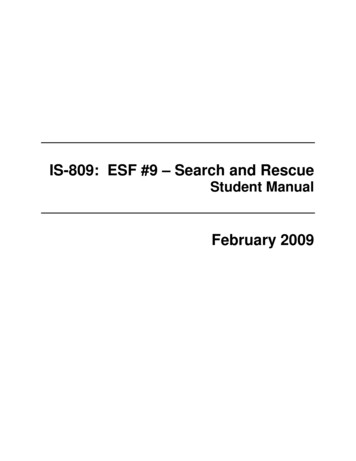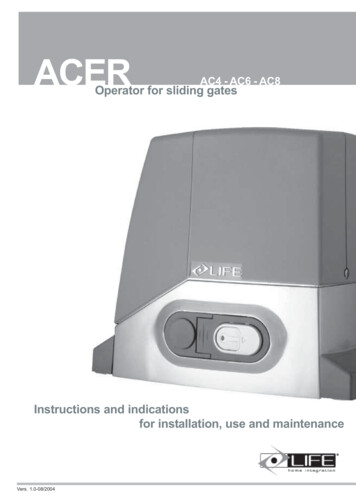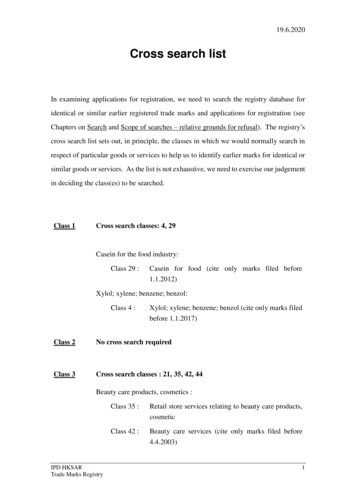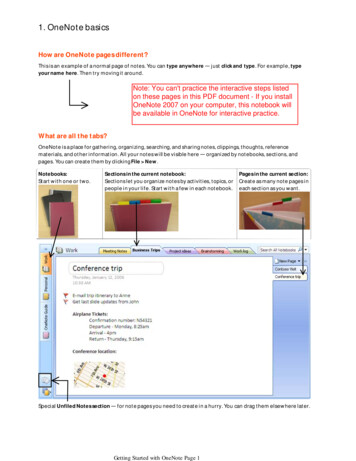
Transcription
IS-809: ESF #9 – Search and RescueStudent ManualFebruary 2009
IS-809: ESF #9 – Search and RescueTopicCourse OverviewDisplayVisual 1Key PointsPurpose: The purpose of this course is to familiarize you with the function and composition ofESF #9 – Search and Rescue.Approximate Time: 1 hourContent Outline: This module includes the following major topics: ESF Overview ESF #9 Purpose and Scope ESF #9 Coordinator and Primary Agencies ESF #9 Support Agencies ESF #9 Concept of Operations ESF #9 Actions Structural Collapse (Urban) Search and Rescue Waterborne Search and Rescue Inland/Wilderness Search and Rescue Aeronautical Search and Rescue SummaryMaterials: Instructor Guide Student Manual (including the ESF #9 – Search and Rescue Annex)February 2009IS-809 ESF #9: Search and RescueStudent ManualPage 1
IS-809: ESF #9 – Search and RescueTopicCourse OverviewDisplayVisual 2Key PointsAt the end of this course, you will be able to: Describe the overall purpose and scope of ESF #9.Identify the supplemental assistance ESF #9 provides to State, tribal, and localgovernments.Identify typical activities accomplished by ESF #9 resources.Describe the types of partnerships formed between ESF #9 and other responseagencies and organizations.February 2009IS-809 ESF #9: Search and RescueStudent ManualPage 2
IS-809: ESF #9 – Search and RescueTopicCourse OverviewDisplayVisual 3Key PointsIntroduce yourself to the members of your table groups, providing: Your name.Your role in emergency management.What you hope to gain from this course.February 2009IS-809 ESF #9: Search and RescueStudent ManualPage 3
IS-809: ESF #9 – Search and RescueTopicESF OverviewDisplayVisual 4Key PointsThe National Response Framework (NRF): Is a guide to how the Nation conducts all-hazards response.Builds upon the National Incident Management System (NIMS) coordinating structuresto align key roles and responsibilities across the Nation, linking all levels of government,nongovernmental organizations, and the private sector.The NRF is comprised of: The Core Document, which describes the doctrine that guides our national response,roles and responsibilities, response actions, response organizations, and planningrequirements to achieve an effective national response to any incident that occurs.Emergency Support Function Annexes, which identify Federal resources and capabilitiesthat are most frequently needed in a national response (e.g., transportation, firefighting,mass care).Support Annexes, which describe essential supporting aspects that are common to allincidents (e.g., financial management, volunteer and donations management, privatesector coordination).Incident Annexes, which address the unique aspects of how we respond to seven broadcategories or types of incidents (e.g., biological, nuclear/radiological, cyber, massevacuation).Partner Guides, which provide ready references describing key roles and actions forlocal, tribal, State, Federal, and private-sector response partners.February 2009IS-809 ESF #9: Search and RescueStudent ManualPage 4
IS-809: ESF #9 – Search and RescueTopicESF OverviewDisplayVisual 5Key PointsThe Federal Government and many State governments organize many of their resources andcapabilities—as well as those of certain private-sector and nongovernmental organizations—under Emergency Support Functions (ESFs).The ESFs: Are coordinated by the Federal Emergency Management Agency (FEMA) through theNational Response Coordination Center (NRCC), Regional Response CoordinationCenters (RRCCs), and Joint Field Offices (JFOs).Are a critical mechanism to coordinate functional capabilities and resources provided byFederal departments and agencies, along with certain private-sector andnongovernmental organizations.Note that some States also have organized an ESF structure along this approach.February 2009IS-809 ESF #9: Search and RescueStudent ManualPage 5
IS-809: ESF #9 – Search and RescueTopicESF OverviewDisplayVisual 6Key PointsReview the general ESF duties listed on the visual.Why is it important that ESFs have the authority to commit agency assets?February 2009IS-809 ESF #9: Search and RescueStudent ManualPage 6
IS-809: ESF #9 – Search and RescueTopicESF OverviewDisplayVisual 7Key PointsThe ESF structure includes: ESF Coordinator. The entity assigned to manage oversight for a particular ESF.Primary Agencies. ESF primary agencies are Federal agencies with significantauthorities, resources, or capabilities for a particular function within an ESF. A Federalagency designated as an ESF primary agency serves as a Federal executive agentunder the Federal Coordinating Officer (or Federal Resource Coordinator for nonStafford Act incidents) to accomplish the ESF mission.Support Agencies. Support agencies are those entities with specific capabilities orresources that support the primary agencies in executing the mission of the ESF.ESFs provide support to other ESFs. For example: ESF #3 – Public Works and Engineeringmay support rural ESF #5 – Emergency Management forces to obtain heavy equipment and/ordemolition services as needed to suppress incident-related fires.February 2009IS-809 ESF #9: Search and RescueStudent ManualPage 7
IS-809: ESF #9 – Search and RescueTopicESF OverviewDisplayVisual 8Key PointsThe ESF coordinator has management oversight for that particular ESF.Note that, as described on the visual, the ESF coordinator has a role throughout the incidentmanagement cycle.February 2009IS-809 ESF #9: Search and RescueStudent ManualPage 8
IS-809: ESF #9 – Search and RescueTopicESF OverviewDisplayVisual 9Key PointsWhen an ESF is activated in response to an incident: The primary agency is responsible for: Serving as a Federal executive agent under the Federal Coordinating Officer (or Federal ResourceCoordinator for non-Stafford Act incidents) to accomplish the ESF mission. Orchestrating Federal support within its functional area for an affected State. Providing staff for the operations functions at fixed and field facilities. Notifying and requesting assistance from support agencies. Managing mission assignments and coordinating with support agencies and appropriate Stateagencies. Working with appropriate private-sector organizations to maximize use of all available resources. Supporting and keeping other ESFs and organizational elements informed of ESF operationalpriorities and activities. Maintaining trained personnel to support interagency emergency response and support teams. Support agencies are responsible for: Conducting operations, when requested by the Department of Homeland Security (DHS) or thedesignated ESF primary agency, using their own authorities, subject-matter experts, capabilities,or resources. Participating in planning for short- and long-term incident management and recovery operationsand the development of supporting operational plans, standard operating procedures (SOPs),checklists, or other job aids, in concert with existing first-responder standards. Assisting in the conduct of situational assessments. Furnishing available personnel or other resource support as requested by DHS or the ESF primaryagency. Providing input to periodic readiness assessments. Participating in training and exercises aimed at continuous improvement of response and recoverycapabilities. Identifying new equipment or capabilities required to prevent or respond to new or emergingthreats and hazards, or to improve the ability to address existing threats.February 2009IS-809 ESF #9: Search and RescueStudent ManualPage 9
IS-809: ESF #9 – Search and RescueTopicESF OverviewDisplayVisual 10Key PointsESFs may be selectively activated for both Stafford Act and non-Stafford Act incidents undercircumstances as defined in Homeland Security Presidential Directive 5 (HSPD-5). Not allincidents requiring Federal support result in the activation of ESFs.FEMA can deploy assets and capabilities through ESFs into an area in anticipation of anapproaching storm or event that is expected to cause a significant impact and result. Thiscoordination through ESFs allows FEMA to position Federal support for a quick response,though actual assistance cannot normally be provided until the Governor requests and receivesa Presidential major disaster or emergency declaration.February 2009IS-809 ESF #9: Search and RescueStudent ManualPage 10
IS-809: ESF #9 – Search and RescueTopicESF OverviewDisplayVisual 11Key PointsThe 15 ESFs are listed on the visual. The complete ESF Annexes are available at the NRFResource Center at www.fema.gov/nrf.This course focuses on ESF #9 – Search and Rescue.Describe your roles or associations with ESF #9.February 2009IS-809 ESF #9: Search and RescueStudent ManualPage 11
IS-809: ESF #9 – Search and RescueTopicESF OverviewDisplayVisual 12Key PointsWhat role does environment play in search and rescue?This course covers the specific capabilities of each of the ESF #9 response partners.February 2009IS-809 ESF #9: Search and RescueStudent ManualPage 12
IS-809: ESF #9 – Search and RescueTopicESF #9 Purpose and ScopeDisplayVisual 13Key PointsESF #9 – Search and Rescue (SAR) provides specialized lifesaving assistance to State, tribal,and local authorities when activated for incidents or potential incidents requiring a coordinatedFederal response.Refer to page 1 of the ESF #9 – Search and Rescue Annex.February 2009IS-809 ESF #9: Search and RescueStudent ManualPage 13
IS-809: ESF #9 – Search and RescueTopicESF #9 Purpose and ScopeDisplayVisual 14Key PointsThe Federal SAR Response System is composed of the primary agencies that providespecialized SAR operations during incidents or potential incidents requiring a coordinatedFederal response. This includes: Structural Collapse (Urban) Search and Rescue (US&R)Waterborne Search and RescueInland/Wilderness Search and RescueAeronautical Search and RescueSAR services include the performance of distress monitoring, communications, location ofdistressed personnel, coordination, and execution of rescue operations including extrication orevacuation along with the provisioning of medical assistance and civilian services through theuse of public and private resources to assist persons and property in potential or actual distress.The scope information can be found on page 1 of the ESF #9 – Search and Rescue Annex.February 2009IS-809 ESF #9: Search and RescueStudent ManualPage 14
IS-809: ESF #9 – Search and RescueTopicESF #9 Coordinator and Primary AgenciesDisplayVisual 15Key PointsThe Federal Emergency Management Agency (DHS/FEMA) is the ESF #9 coordinator.Primary agencies for ESF #9 are: DHS/FEMADHS/U.S. Coast Guard (USCG)Department of the Interior/National Park Service (NPS)Department of Defense/U.S. Air Force (USAF)More information can be found on pages 4-6 of the ESF #9 – Search and Rescue Annex.February 2009IS-809 ESF #9: Search and RescueStudent ManualPage 15
IS-809: ESF #9 – Search and RescueTopicESF #9 Support AgenciesDisplayVisual 16Key PointsIn addition to its four primary agencies, ESF #9 is served by a number of support agencies.This support includes: Customs and Border Protection provides specialized response.National Aeronautics and Space Administration provides emerging technologies.Army Corps of Engineers provides engineering and expertise.Forest Service provides equipment and supplies.Department of Health and Human Services provides medical expertise.February 2009IS-809 ESF #9: Search and RescueStudent ManualPage 16
IS-809: ESF #9 – Search and RescueTopicESF #9 Concept of OperationsDisplayVisual 17Key PointsActivation of ESF #9 is dependent upon the nature and magnitude of the event, the suddennessof onset, and the existence of State and local resources in the affected area.Depending on the type of incident, the appropriate primary agency will initiate responseactivities. For example, in a maritime distress situation, the U.S. Coast Guard will initiateFederal waterborne search and rescue response activities.February 2009IS-809 ESF #9: Search and RescueStudent ManualPage 17
IS-809: ESF #9 – Search and RescueTopicESF #9 ActionsDisplayVisual 18Key PointsSearch and rescue services provided under ESF #9 include: Monitoring distress alerts.Locating distressed personnel.Coordinating rescue efforts.Extricating or evacuating victims.Providing medical assistance.February 2009IS-809 ESF #9: Search and RescueStudent ManualPage 18
IS-809: ESF #9 – Search and RescueTopicESF #9 ActionsDisplayVisual 19Key PointsWhat are some examples of the types of search and rescue operations each primary agencyperforms?February 2009IS-809 ESF #9: Search and RescueStudent ManualPage 19
IS-809: ESF #9 – Search and RescueTopicStructural Collapse (Urban) Search and RescueDisplayVisual 20Key PointsFEMA serves as the primary agency in US&R missions.FEMA follows the National US&R Response System to deploy US&R task forces, IncidentSupport Teams, and technical specialists.FEMA’s National Urban Search and Rescue Response System has been deployed for searchesof collapsed or damaged buildings in incidents nationwide, including the Oklahoma Citybombing, the collapse of the World Trade Center, and rescue efforts after Hurricane Katrina.Also during Hurricane Katrina, 28 National US&R task forces were mobilized. The teamsrescued more than 6,000 individuals.February 2009IS-809 ESF #9: Search and RescueStudent ManualPage 20
IS-809: ESF #9 – Search and RescueTopicStructural Collapse (Urban) Search and RescueDisplayVisual 21Key PointsFEMA’s National US&R Response System organizes local emergency personnel into integrateddisaster response task forces. These task forces, complete with necessary tools andequipment, and specialized training and skills, are deployed by FEMA in times of catastrophicstructural collapse.There are 28 national task forces situated across the country. The entire US&R ResponseSystem is comprised of more than 5,000 individuals.US&R teams include specially trained canines that can help locate survivors in an incident.Approximately 80 FEMA canines were active in rescue efforts at the World Trade Center attacksite. They and their handlers were members of the 20 FEMA US&R teams deployed to supportthe City of New York.February 2009IS-809 ESF #9: Search and RescueStudent ManualPage 21
IS-809: ESF #9 – Search and RescueTopicStructural Collapse (Urban) Search and RescueDisplayVisual 22Key PointsEach task force has five main components: Search: Locating victims of a disaster.Rescue: Removing a victim from the location where he or she is trapped, which ofteninvolves removing debris from around the victim.Medical: Providing confined-space medical treatment for victims before, during, andafter rescue.Technical: Providing technical support for the rescuers, such as structural engineers,hazmat specialists, and communications specialists.Logistical: Providing logistics specialists responsible for the transportation,maintenance, tracking, and rehabilitation of task force equipment.February 2009IS-809 ESF #9: Search and RescueStudent ManualPage 22
IS-809: ESF #9 – Search and RescueTopicWaterborne Search and RescueDisplayVisual 23Key PointsUSCG serves as the primary agency in Waterborne SAR missions.USCG coordinates response from an agency-designated command center (Area/District/Sector)or the Rescue Coordination Center, Rescue Sub-Center, or Joint Rescue Coordination Centernearest to the affected area.February 2009IS-809 ESF #9: Search and RescueStudent ManualPage 23
IS-809: ESF #9 – Search and RescueTopicWaterborne Search and RescueDisplayVisual 24Key PointsUSCG SAR response involves multi-mission stations, cutters, aircraft, and boats linked bycommunications networks.The Coast Guard maintains SAR facilities on the east, west, and gulf coasts; in Alaska, Hawaii,Guam, and Puerto Rico; and on the Great Lakes and inland U.S. waterways. USCG SAR unitsare positioned to arrive onsite within 2 hours of the initial notification.The Coast Guard search and rescue crews include rescue swimmers, emergency medicaltechnicians, and first responders.February 2009IS-809 ESF #9: Search and RescueStudent ManualPage 24
IS-809: ESF #9 – Search and RescueTopicInland/Wilderness Search and RescueDisplayVisual 25Key PointsDOI serves as the primary agency for Inland/Wilderness SAR missions.DOI coordinates response from a regional office.Search and rescue efforts in DOI areas range from searching for lost hikers to performingcomplex technical rescues in high altitude, mountainous environments.February 2009IS-809 ESF #9: Search and RescueStudent ManualPage 25
IS-809: ESF #9 – Search and RescueTopicInland/Wilderness Search and RescueDisplayVisual 26Key PointsThe National Park Service (NPS) is the inland SAR subject-matter expert and has hundreds oftrained rangers in SAR operations from cliff rescues to helicopter evacuations in all parkenvironments. In addition, the NPS has nearly 300 rangers trained as emergency medicaltechnicians.Note that Bureau of Land Management rangers and National Wildlife Refuge System lawenforcement officers also provide search and rescue services in their areas.February 2009IS-809 ESF #9: Search and RescueStudent ManualPage 26
IS-809: ESF #9 – Search and RescueTopicAeronautical Search and RescueDisplayVisual 27Key PointsUSAF serves as the primary agency for Aeronautical SAR missions.USAF coordinates initial actions from its Rescue Coordination Center. If significant DODresources are required, a Joint Task Force is activated.February 2009IS-809 ESF #9: Search and RescueStudent ManualPage 27
IS-809: ESF #9 – Search and RescueTopicAeronautical Search and RescueDisplayVisual 28Key PointsFor aerial searches, the Air Force calls on the Civil Air Patrol, the official auxiliary of the AirForce. The Patrol conducts the majority of all aerial search activity in the inland area. Aerialsearch activities are coordinated through the Air Force Rescue Coordination Center at LangleyAir Force Base.The Civil Air Patrol (CAP) is a congressionally chartered, nonprofit organization of volunteers.As the official auxiliary of the U.S. Air Force, CAP conducts approximately 95 percent of allaerial search activity in the inland area.In addition to the world’s largest fleet of single-engine, piston aircraft; the Nation’s mostextensive communications network; and more than 1,000 emergency services vehicles, theCAP provides SAR mission coordinators, ground teams, and additional personnel on alertstatus.February 2009IS-809 ESF #9: Search and RescueStudent ManualPage 28
IS-809: ESF #9 – Search and RescueTopicSummaryDisplayVisual 29Key PointsInstructions: Answer the review questions on pages 32 and 33 of your Student Manual.Be prepared to share your answers with the class in 5 minutes.If you need clarification on any of the material presented in this course, be sure to askyour instructors.Additional information about the National Response Framework and Emergency SupportFunctions can be obtained at the NRF Resource Center at www.fema.gov/nrf.February 2009IS-809 ESF #9: Search and RescueStudent ManualPage 29
IS-809: ESF #9 – Search and RescueTopicSummaryDisplayVisual 30Key PointsInstructions:1. Take a few moments to review your Student Manuals and identify any questions.2. Make sure that you get all of your questions answered prior to beginning the final test.3. When taking the test . . . Read each item carefully. Circle your answer on the test. Check your work and transfer your answers to the computer-scan (bubble)answer sheet or enter the answers online.You may refer to your Student Manuals and the annex when completing this test.February 2009IS-809 ESF #9: Search and RescueStudent ManualPage 30
IS-809: ESF #9 – Search and RescueTopicSummaryDisplayVisual 31Key PointsPlease complete the course evaluation/feedback form.February 2009IS-809 ESF #9: Search and RescueStudent ManualPage 31
IS-809: ESF #9 – Search and RescueESF #9 – Knowledge Review1. Who serves as the coordinator for ESF #9?2. Which agency would most likely act as the primary agency if ESF #9 were activated torescue of cruise ship passengers from a liner damaged by a tropical storm?3. Which agency would most likely act as the primary agency if ESF #9 were activated tosearch for survivors of an airliner downed by an apparent terrorist attack?4. Which agency would most likely act as the primary agency if ESF #9 were activated torescue of residents of a rural area trapped by a sudden severe ice storm?5. Which resource consists of highly trained and well-equipped local fire and emergencypersonnel?Task forcesIncident support teamsTechnical specialists6. Fill in the blank: Theall aerial search activity in the inland area.February 2009conducts approximately 95 percent ofIS-809 ESF #9: Search and RescueStudent ManualPage 32
IS-809: ESF #9 – Search and Rescue7. Match the activities with the ESF #9 support agencies that perform them.ActivitiesSupport AgenciesSupplies equipment for searches inwilderness and forested areasA. USDA/Forest ServiceProvides test-bed facilities for proof-ofconcept and beta testing of new SARtechnologies.B. Department of Healthand Human ServicesConducts specialized search and rescueoperations along the U.S.-Mexico border.C. DHS/Customs andBorder ProtectionOffers engineering expertise in searches ofcollapsed buildings.D. National Aeronauticsand SpaceAdministrationProvides support to Emergency MedicalTechnicians working in a Coast Guard searchand rescue team.E. DOD/U.S. Army Corpsof Engineers8. Use the space below to make note of any questions you have about the material covered inthis course.February 2009IS-809 ESF #9: Search and RescueStudent ManualPage 33
IS-809: ESF #9 – Search and RescueYour NotesFebruary 2009IS-809 ESF #9: Search and RescueStudent ManualPage 34
Inland/Wilderness Search and Rescue Aeronautical Search and Rescue Summary . Materials: Instructor Guide Student Manual (including the ESF #9 – Search and Rescue Annex) IS-809: ESF #9 – Search and Rescue February 2009 IS-809 ESF #9: Search a










